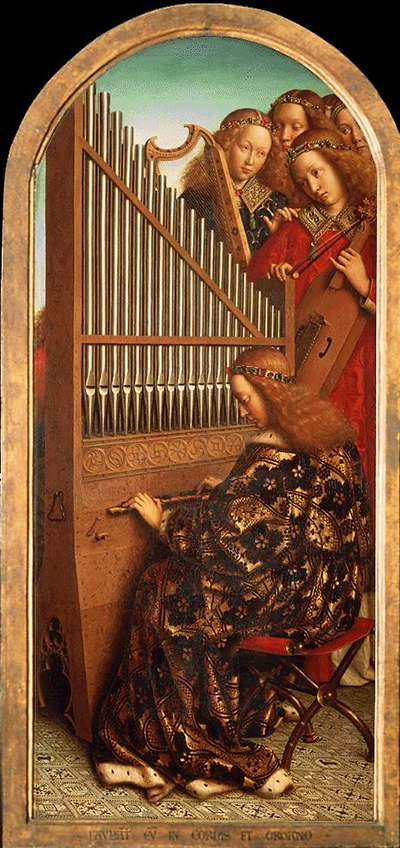Music Making Angels features a beautiful array of young women playing a variety of traditional musical instruments. The painting covered a single panel within a complex triptych arrangement and here we focus closely just on this particular piece.
Van Eyck was a highly accomplished painter who impressed in several different genres. His portraiture allowed him to take on many commissions for notable individuals and without absorbing too much of his time on a single project. He also brought assistants from his workshop along for the more complex pieces, allowing them to contribute to elements of the scene whilst under his direct supervision. In some cases two of his brothers also helped out and were respected painters in their own right. This has led to issues with attribution, however, as very little documentation was left behind to explain the specific role of each artist. Even after his death, several of his works were finished off by members of his studio which essentially extended his career beyond his own lifetime, normally led by the work that he had already completed as well as study drawings and under painting that led them in the right direction.
We find a curved panel here, which is flat at the bottom. Most figures are placed in the top right, bunched together behind the main organ. They have old versions of a sort of violin and also a harp. They have long curly hair and are facially all very similar, suggesting that they are related or simply that the artist liked to style portraits in this way. The organist sits on a wooden chair with red cover, leaning over to play this large instrument which dominates most of the scene. The flutes are carefully done, ensuring that the straight lines are accurately reproduced. There is also some ornate wood sculpturing around the bottom of the flutes and a dappled effect below that. The floor is tiled with a series of different patterns and the main organist is also beautifully dressed, with a silk dress which engulfs her body in its entirety. They each wear jewelled bands around their heads and have blonde or auburn hair which gives a real Northern European feel to the overall piece.
The connection between art and music has long been used by painters within their work. Originally it was in ways such as this, where musicians were depicted along with their instruments, sometimes in social settings. Later on as we moved into the 20th century there was a great attempt to actually turn sound into visual art and this was accomplished by the likes of Kandinsky and Klee within their far more abstract styles. Items such as the painting in front of us here also help to give us more information about the type of instruments used during this period within that part of Europe, with very precise, realistic styles used by the likes of Van Eyck.




